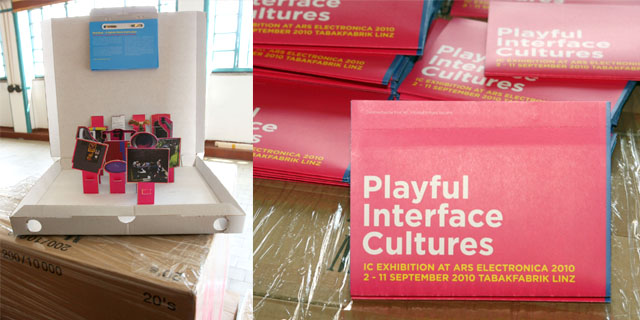As a summary, just to get a short overview, I elected together with an eight-year-old boy his ten favourites, also to focus on what´s most interesting for the younger generation and how they interact with media art.
“Otamatone”- Novmichi Tosa, Maylsa Denki: musical-note-shaped electric instrument
“Gear Box”- Ulrich Brandstätter & Oliver Buchtala: kind of musical loop-sequencer
“Paro”- Aist : Therapeutic Robot with 5 kinds of sensors: tactile, light, audition, temperature and posture sensors. It can learn to behave in a way that the user prefers and simulates interaction between patients and caregivers.
“TalkTorque-2″- Hideaki Kuzuoka, Hiroshi Kasai, Ikkaku Kawaguchi, Toshimasa Yamanaka: guide robot that utilizes human skills
“Is there a horizon in the deep water?” -HEHE: Helen Evans, Heiko Hansen: Installation, Performance which works through the ecological tragedy, the explosion of the oil platform Deep Horizon in 2010, by reconstructing the event minutely.
“Six-Fourty by Fourty-Eghty”- Jamie Ziegelbaum, Marcelo Coelo: Installation, handy magnetic pixels as an interpretation of the touchscreen principle, by touching they change the color or copy it onto another
“Shadows”- Jyun-ya Kataoka: Installation, device, consisting of a turntable, found at a garage dump, and strobes from instant cameras attached to a circle, by rotating the turntable you manipulate the shadows
“Paricles”- Daito Manabe, Motoi Ishibashi: On a construction that resembles a rollercoaster, lightballs can be orchestrated via control-screen to whiz about in all directions and grouped into moving patterns.
“Running through the fog” at the roof of the O.K.-house: just a part of the “Hoehenrausch”
“CCD-me-not-Umbrella”- Mark Shepard: of sentient city survival kit: An umbrella studded with infrared Leds visible only to CCD surveillance cameras, designed to frustrate object-detection-algorithms used in computer vision surveillance systems


Socialize